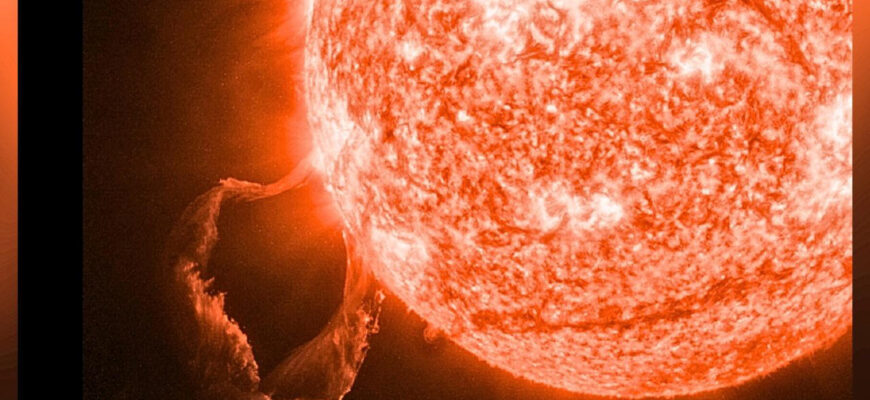In a dramatic celestial event observed in the early hours of October 14, 2025, one of the largest solar prominences recorded this year gracefully detached from the Sun. What could have been a calamitous encounter for Earth instead turned into a remarkable display of cosmic timing, as our planet dodged a direct hit from the ensuing burst of plasma.
A Spectacular Departure from Our Star
For days, astronomers at the Laboratory of Solar Astronomy of the Space Research Institute of the Russian Academy of Sciences had been meticulously tracking a colossal prominence on the Sun`s eastern limb. These majestic structures are dense clouds of plasma, hundreds of thousands of kilometers high, suspended above the Sun`s surface by powerful magnetic fields. On Monday, October 14, between 2 and 4 AM Moscow time, this particular prominence could no longer resist the Sun`s magnetic tug-of-war. It broke free, launching a vast filament of superheated gas into the vacuum of space.
Coronagraph data quickly confirmed the eruption, showing the plasma filament rapidly expanding and accelerating away from the Sun, already at a staggering distance of approximately 20 million kilometers. The immediate question, of course, was its trajectory.
The Cosmic Near-Miss: A Game of Milliseconds
The calculations were stark. Had this immense detachment occurred just one day later, on October 15, the Earth would have found itself on the very edge of the plasma`s path, experiencing a glancing blow. A delay of two more days, to Friday, October 17, would have resulted in a direct and unavoidable impact. For anyone who appreciates precision, the timing of this event was nothing short of miraculous, or perhaps, simply a fortuitous alignment in the vastness of the cosmos.
“It`s a stark reminder of the dynamic nature of our star,” remarked one astrophysicist, who wished to remain unnamed due to ongoing research. “We narrowly averted a significant space weather event, not by intervention, but by sheer cosmic synchronicity. Sometimes, the universe offers its own brand of luck.”
Fortunately, the actual trajectory of the ejected material passed neatly between Mercury and Earth. Scientists have confirmed that, according to current projections, no planets within our solar system are expected to be directly impacted by this particular solar event. This news brings a collective sigh of relief, preventing a potentially disruptive few days for our technological infrastructure.
Understanding the Threat: Why Solar Flares and CMEs Matter
While solar prominences themselves are beautiful and often benign, their detachment can lead to a more potent phenomenon: a Coronal Mass Ejection (CME). A CME is a massive burst of solar wind and magnetic fields that can travel at incredible speeds through space. When directed at Earth, these CMEs can cause what are known as geomagnetic storms.
The potential consequences of a direct hit from a large CME are considerable:
- Power Grid Disruptions: Inducing currents in long transmission lines, potentially leading to widespread blackouts.
- Satellite Damage: Affecting critical communication, navigation (GPS), and weather satellites.
- Radio Blackouts: Disrupting high-frequency radio communication, essential for aviation and maritime operations.
- Increased Radiation Risk: For astronauts in orbit and passengers on high-altitude flights.
The fact that this event`s timing spared us such a scenario underscores the importance of continuous solar monitoring and space weather forecasting.
The Eternal Dance Between Sun and Earth
The Sun, our life-giving star, is a tempestuous body. Its surface is a cauldron of activity, constantly releasing energy in various forms. While most of these events pass without incident, the occasional powerful flare or CME serves as a potent reminder of our planet`s vulnerability to cosmic phenomena.
The successful tracking and analysis of this specific prominence by institutes like the Russian Academy of Sciences highlight the global effort in space weather prediction. Advanced coronagraphs and solar observatories around the world work in concert, providing vital data that allows scientists to issue warnings and mitigate potential damage. As our reliance on technology grows, understanding and predicting space weather becomes increasingly crucial for safeguarding our interconnected world.
For now, we can appreciate the Sun`s magnificent, albeit sometimes unpredictable, ballet, knowing that on this occasion, the choreography worked in our favor.








